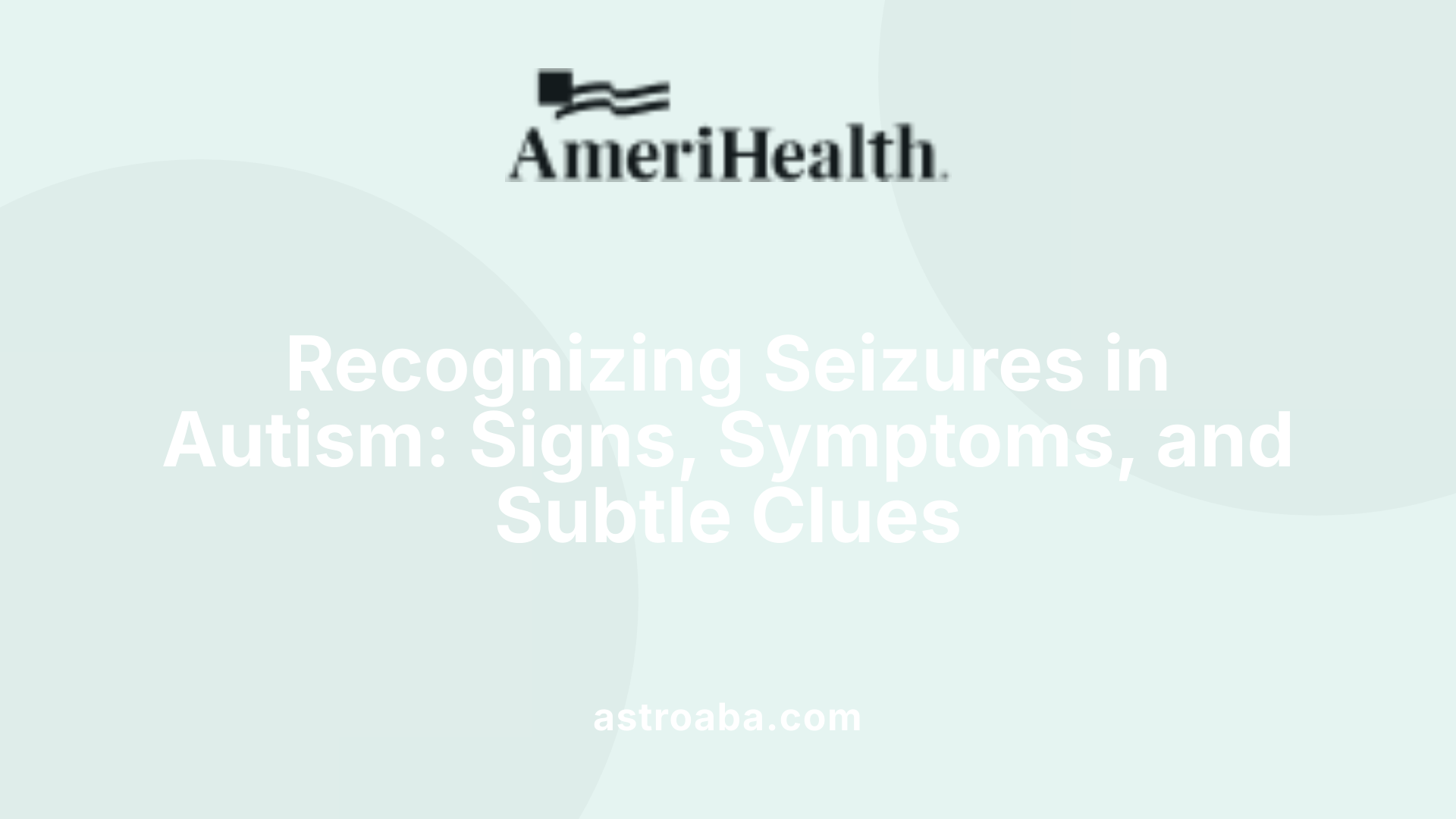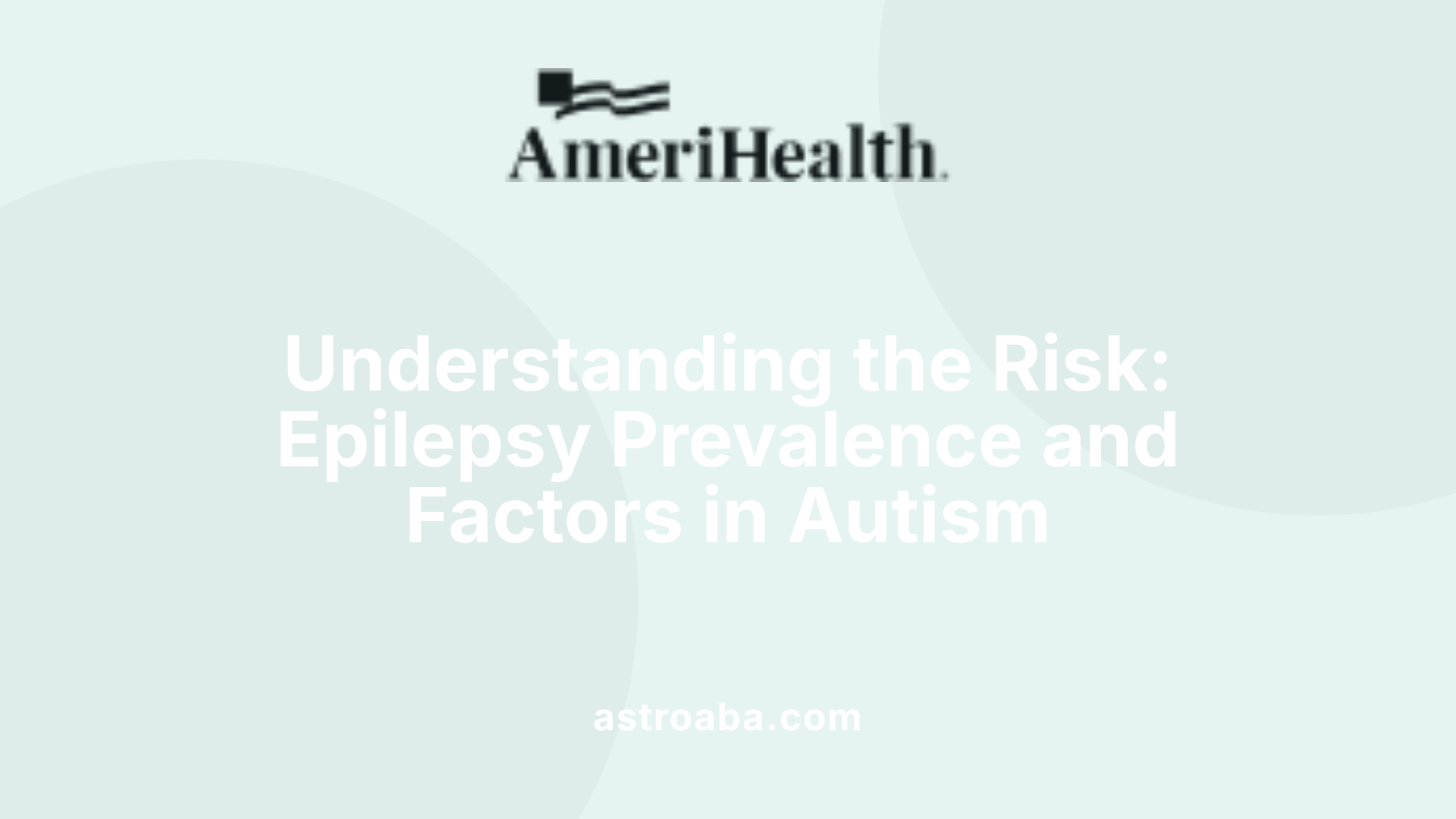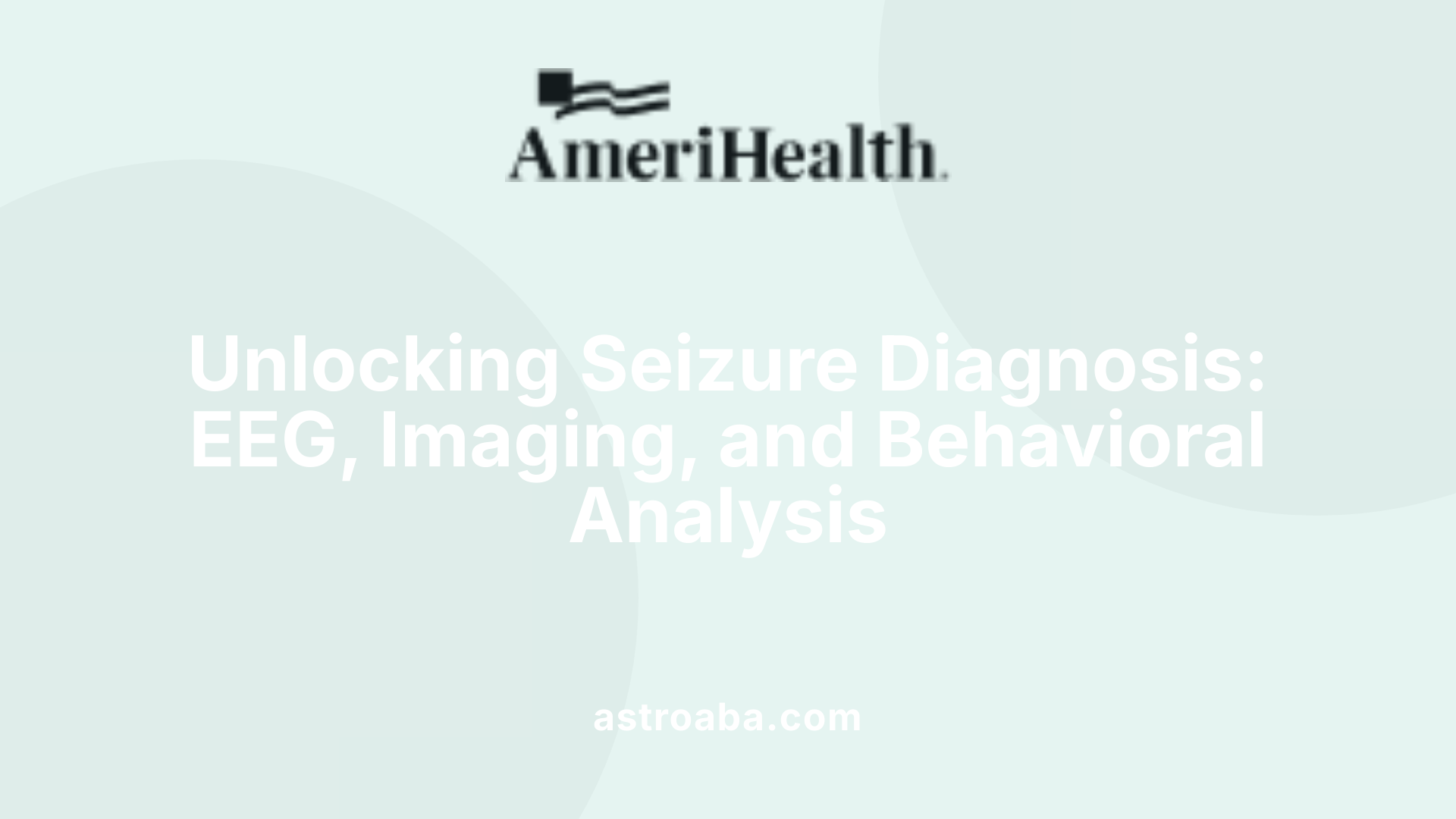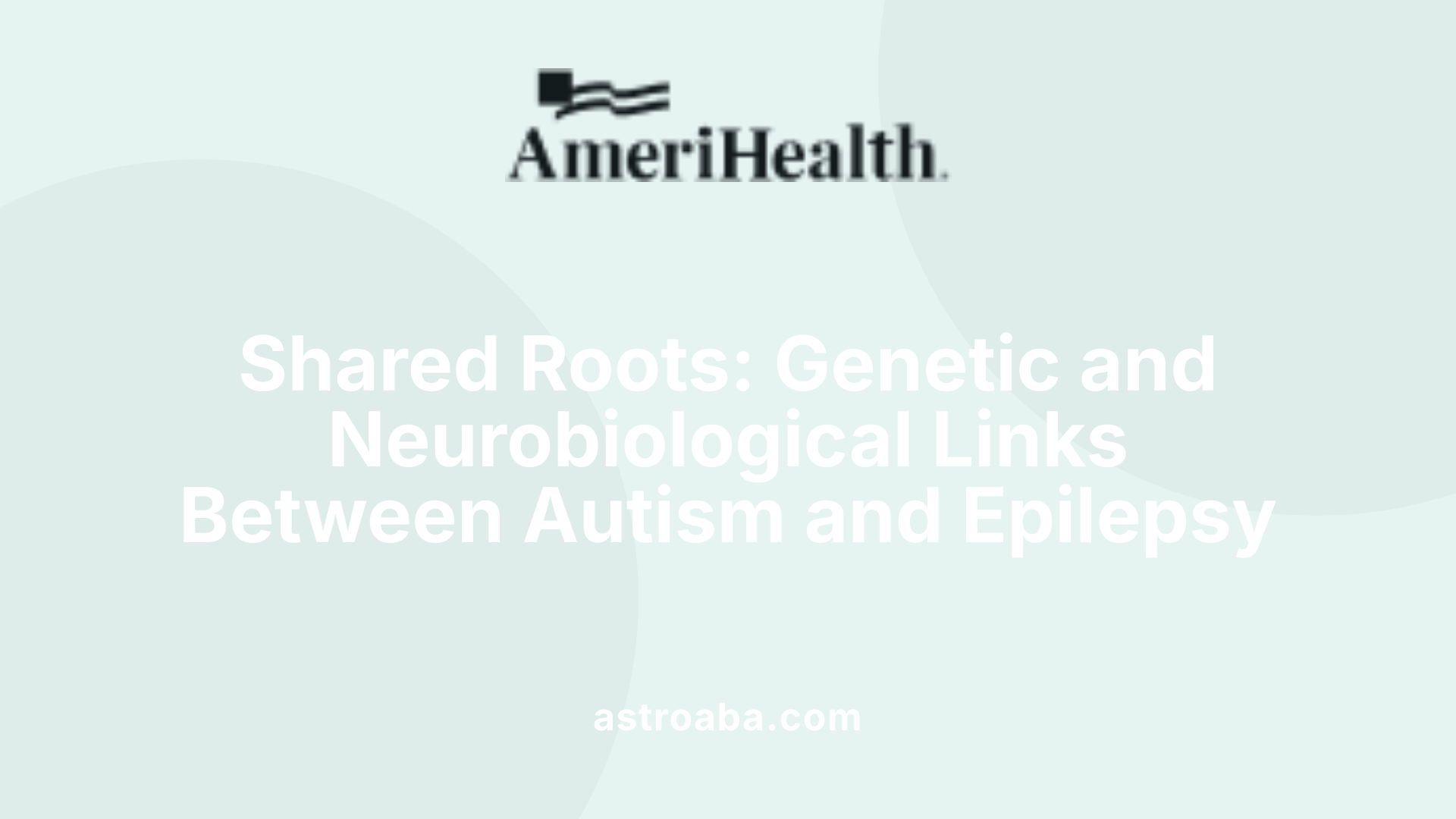Autism and Seizures/Epilepsy
Exploring the Complex Relationship Between Autism and Epilepsy

Understanding the High Co-Occurrence of Autism and Seizures
Autism Spectrum Disorder (ASD) and epilepsy are two neurological conditions that frequently co-occur, presenting unique challenges in diagnosis and management. With estimates suggesting that up to 30% of children with autism experience seizures—significantly higher than the 1-2% prevalence in the general population—it is crucial to explore their interrelated biological, genetic, and environmental factors. This comprehensive overview aims to illuminate the symptoms, diagnosis, underlying mechanisms, and treatment strategies associated with autism and epilepsy, providing a vital resource for clinicians, caregivers, and researchers.
Symptoms and Recognition of Seizures in Autism

What are the typical symptoms of seizures in individuals with autism?
Seizures in individuals with autism can present with a variety of symptoms, which may sometimes resemble behaviors associated with autism itself. Common signs include involuntary jerking or stiffening of muscles, episodes of staring or unresponsiveness, and loss of awareness or consciousness. Some individuals may experience confusion after a seizure, or report unusual sensations such as auras. These episodes might also manifest as quick, repetitive movements, sudden loss of balance, or sudden behavioral changes like agitation or disorientation.
Because symptoms can be subtle and overlap with autistic behaviors, recognizing seizures requires close observation and often medical evaluation. Some individuals demonstrate no outward signs during a seizure, known as silent or subclinical seizures, which makes EEG monitoring an important tool in diagnosis.
Seizures can also be triggered or accompanied by other sensations or perceptions such as tingling, flashing lights, or unusual smells. The variability in presentation makes awareness and early detection critical to prevent potential complications, especially in children with communication difficulties.
What types of seizures are observed in people with autism, and what are their clinical features?
People with autism experience a range of seizure types, reflecting diverse electrical activity disturbances within the brain. The most frequently observed include focal (partial) seizures and generalized seizures.
Focal seizures, which affect only a part of the brain, may involve subtle symptoms like rhythmic twitching, lip smacking, or facial grimacing. These seizures can evolve into generalized seizures affecting the entire brain, leading to loss of consciousness and convulsions.
Generalized seizures include various forms such as absence seizures, tonic-clonic seizures, myoclonic seizures, and atonic seizures. Absence seizures, often brief, present as staring spells with rapid blinking or subtle movements, and children might appear to be 'daydreaming.' Tonic-clonic seizures involve stiffening (tonic phase) followed by jerking movements (clonic phase), and may include loss of bladder control.
Atonic seizures cause sudden loss of muscle tone, resulting in drop attacks, while myoclonic seizures produce quick, shock-like jerks. Severe forms like infantile spasms are characterized by sudden flexion or extension movements and are associated with certain syndromes like tuberous sclerosis.
The age of onset for seizures in autistic individuals varies, often starting in adolescence or early adulthood, but some can occur in infancy. Diagnosing these seizures involves EEG recordings, which reveal abnormal electrical discharges, and neuroimaging.
Treatment generally includes anti-epileptic medications tailored to the seizure type. In some cases, dietary therapies like the ketogenic diet or neurostimulation methods such as vagus nerve stimulation are utilized.
While seizures can impact overall health, they typically do not worsen core autism symptoms, though effective management is essential to reduce risks of injury, cognitive decline, and behavioral disruptions.
Summary Table:
| Seizure Type | Clinical Features | Typical Age of Onset | Diagnostic Methods | Treatment Options |
|---|---|---|---|---|
| Focal (Partial) | Jerking, lip smacking, localized twitching | Varies, often in childhood or adolescence | EEG, MRI | Anti-epileptic drugs, diet, stimulation |
| Absence | Staring, eyelid blinking | Usually childhood | EEG, clinical observation | Medication (ethosuximide, valproate) |
| Tonic-Clonic | Stiffening, rhythmic jerking, loss of consciousness | Often in adolescence or young adult | EEG, brain imaging | AEDs, surgical options |
| Atonic | Sudden loss of muscle tone, drop attacks | Childhood to adolescence | EEG | AEDs, safety precautions |
| Myoclonic | Quick shock-like jerks | Variable | EEG | AEDs, dietary therapy |
Understanding the diverse seizure manifestations in autism is essential for early diagnosis and personalized treatment. It also underscores the importance of multidisciplinary care involving neurologists, psychiatrists, and specialists in autism to optimize outcomes.
Prevalence and Risk Factors of Epilepsy in Autism

What is the prevalence of epilepsy in individuals with autism?
Research indicates that epilepsy is a common comorbidity in those on the autism spectrum. Approximately 12% of autistic individuals also have a diagnosis of epilepsy, though some studies report higher figures, up to 30%. The occurrence of epilepsy tends to increase with age, with most cases manifesting during adolescence and young adulthood. Notably, the likelihood of developing epilepsy is higher among individuals with autism who also have intellectual disabilities, with prevalence rates reaching 20% or more in those with severe cognitive impairments. The onset of seizures typically occurs in early childhood, particularly in the first decade, but some individuals experience their first seizures during or after adolescence.
The overlap between autism and epilepsy is linked to shared genetic factors. Conditions such as Rett syndrome, Fragile X syndrome, and Tuberous sclerosis are especially notable, as they are associated with high rates of both disorders. Abnormal electrical activity in the brain, often detected via EEG, correlates with behavioral regression and cognitive decline in some cases, highlighting the interconnected nature of these conditions.
Are there particular demographic groups more affected, and what risk factors contribute to comorbidity?
Certain demographic characteristics influence the prevalence of epilepsy in autistic populations. For example, research shows that women and girls with autism are somewhat more prone to developing epilepsy than males, with prevalence rates in females extending beyond 15%, compared to approximately 10% in males. The severity of intellectual disability also plays a significant role: individuals with profound cognitive impairments experience the highest rates of epilepsy, with some studies citing prevalence of 40% or more in this group.
Genetic predispositions are a major contributor to the co-occurrence. Syndromes such as Rett syndrome, which involves mutations in the MECP2 gene, and Fragile X syndrome, linked to mutations in the FMR1 gene, show high comorbidity rates. Tuberous sclerosis, caused by mutations in TSC1 or TSC2 genes, is another condition with a strong association with both autism and epilepsy.
Environmental factors also increase risk. Prenatal exposures, intrauterine infections, and complications during delivery, such as brain injuries, elevate the chances of developing both conditions. These factors underscore the importance of comprehensive early screening and monitoring, especially for children with known genetic syndromes or prenatal risk factors.
Age is a critical element in the risk profile. Seizures most commonly appear during adolescence or early adulthood, but they can also originate in early childhood. Vigilance during these developmental windows can facilitate earlier diagnosis and intervention.
| Demographic Characteristics | Impact on Epilepsy Prevalence | Contributing Factors |
|---|---|---|
| Gender (Female vs. Male) | Higher in females (~15%) | Hormonal influences, genetic susceptibility |
| Severity of intellectual disability | Up to 40% in severe cases | Genetic syndromes, brain developmental anomalies |
| Age at onset | Usually in childhood or adolescence | Brain maturation, genetic predisposition |
| Associated syndromes (e.g., Rett, Tuberous sclerosis) | Very high prevalence rates | Genetic mutations, neurodevelopmental pathways |
This demographic and genetic diversity emphasizes the need for tailored assessment and support. Continuous research into the shared biological mechanisms promises avenues for improved treatments and interventions, minimizing the impact of seizures on the development and quality of life of autistic individuals.
Diverse Seizure Types and Their Manifestations in Autism

What types of seizures are observed in people with autism, and what are their clinical features?
Individuals with autism spectrum disorder (ASD) can experience a wide range of seizure types, reflecting the complexity of neurological involvement in these conditions. The most common seizure forms include focal (partial) seizures, which originate in a specific area of the brain and may present with subtle symptoms such as involuntary movements, tingling sensations, or altered awareness. These seizures can sometimes evolve into generalized seizures affecting the entire brain.
Generalized seizures are also prevalent among autistic individuals, with several subtypes documented. These include absence seizures (petit mal), characterized by brief episodes of staring and unresponsiveness; tonic-clonic seizures (grand mal), involving stiffening followed by rhythmic jerking; myoclonic seizures, which feature sudden involuntary muscle jerks; and atonic seizures, marked by sudden loss of muscle tone causing drop attacks. Additionally, syndromes like infantile spasms, also known as West syndrome, are strongly associated with autism, especially in children with genetic conditions such as tuberous sclerosis.
Clinically, seizures often manifest through episodes of staring, stiffening, rhythmic twitching, loss of consciousness, or behavioral disturbances. Some children may experience complex behaviors during seizures, like automatisms or bizarre posturing. However, overlapping autism behaviors such as withdrawal or repetitive movements can complicate seizure identification.
Prevalence estimates indicate that anywhere from 5% up to over 30% of children on the autism spectrum are affected by seizures at some stage in their development. Most seizures tend to begin during adolescence or even adulthood; however, some onset during early childhood. The subtlety of seizure symptoms makes diagnosis challenging, underscoring the importance of thorough evaluation.
Diagnosis typically involves electroencephalogram (EEG) monitoring to record electrical activity in the brain, which can reveal epileptiform discharges or abnormal wave patterns associated with seizure activity. Brain imaging, such as MRI, is used to identify underlying structural abnormalities linked to certain syndromes.
Treatment strategies are tailored based on seizure type and severity. Anti-epileptic drugs (AEDs) are the mainstay of therapy, with options chosen to minimize behavioral side effects. For cases resistant to medication, non-pharmacologic therapies like ketogenic diets, vagus nerve stimulation, or surgical interventions may be considered.
Although seizures in individuals with autism are generally not more severe than in other populations, their impact on functioning can be significant, especially if poorly controlled. Moreover, some seizures may contribute to behavioral regressions or exacerbate developmental challenges.
In summary, seizures in autism are diverse both in their clinical presentation and electroencephalographic features. Recognizing these variations is essential for proper diagnosis and effective management, aiming to improve quality of life and developmental outcomes for affected individuals.
Diagnostic Procedures and Tools for Seizures in Autism

What procedures and tools are used for diagnosing seizures in individuals with autism?
Diagnosing seizures in individuals with autism relies primarily on specialized tools and procedures that can detect abnormal electrical activity in the brain. The most common initial test is the electroencephalogram (EEG), which records electrical signals from brain cells. In autistic patients, high-density EEG recordings, sometimes combined with video monitoring, provide detailed insights and help localize seizure origins more accurately.
Beyond EEG, neuroimaging techniques are crucial. Magnetic resonance imaging (MRI) and computed tomography (CT) scans are standard methods used to identify structural abnormalities or lesions that might provoke seizures. Functional imaging modalities like positron emission tomography (PET), single-photon emission computed tomography (SPECT), and magnetoencephalography (MEG) can provide metabolic and functional data about the brain, highlighting areas of abnormal activity.
A comprehensive diagnosis incorporates clinical history, caregiver observations, and video recordings of episodes. Since many behaviors in autism can imitate seizure activity, these recordings assist clinicians in differentiating true seizures from stereotyped autistic behaviors. In some cases, genetic testing, blood work, or neurological examinations supplement imaging and EEG data to reveal underlying causes, especially in cases linked to genetic syndromes.
Challenges in detecting seizures in autistic individuals
Identifying seizures in children with autism presents unique difficulties. A primary challenge is the overlap between seizure symptoms and autistic behaviors. For example, staring episodes, withdrawal, or repetitive movements may be mistaken for autistic stereotypies or attention issues, causing delays or misdiagnosis.
Communication barriers further complicate detection. Non-verbal children or those with limited language skills may not be able to describe sensations or experiences during seizures, leaving caregivers and clinicians to rely solely on observed behaviors. Some seizures, especially subclinical or silent seizures, do not produce obvious outward signs, making EEG monitoring essential.
The variability in seizure presentation—some with subtle signs and others with more dramatic episodes—necessitates a multidisciplinary approach. Neurologists, psychologists, and caregivers often work together, utilizing ambulatory EEG or prolonged inpatient EEG studies when necessary. Accurate diagnosis depends on correlating clinical observations with diagnostic tests to differentiate seizures from other behaviors such as sleep disturbances, reflux, or behavioral outbursts.
In summary, while EEG and neuroimaging are vital tools, their effectiveness depends on careful application and interpretation. Overcoming detection challenges hinges on detailed behavioral assessments, awareness of seizure signs, and comprehensive, often repeated, diagnostic evaluations to ensure timely and accurate diagnosis for effective management.
Biological, Genetic, and Neurodevelopmental Links between Autism and Epilepsy

What biological, genetic, or neurological mechanisms link autism and epilepsy?
Research suggests that autism and epilepsy share several biological, genetic, and neurodevelopmental pathways. These conditions often co-occur because they involve similar disruptions in brain structure and function.
At the molecular level, mutations in genes such as SHANK3, SCN2A, and MECP2 are linked to both autism and epilepsy. These genes are essential for synaptic development, neuronal signaling, and the regulation of neural circuits. When these genes are altered, they can impair the balance between inhibitory and excitatory signaling in the brain.
This imbalance is a central feature connecting the two disorders. An overactive excitatory system or a reduced inhibitory mechanism, often involving gamma-aminobutyric acid (GABA) and glutamate neurotransmitters, can cause the brain to become more prone to seizure activity. Such disruptions also interfere with normal neurodevelopmental processes, contributing to autism behaviors.
Certain genetic syndromes, like Tuberous sclerosis and fragile X syndrome, exemplify signatures of that shared pathway. These syndromes involve genetic mutations that influence cellular growth, synaptic connectivity, and neuronal excitability, thereby increasing risk for both autism and epilepsy.
Research into copy number variants (CNVs) and specific gene mutations has revealed disturbances in pathways governing gene regulation, cellular growth, and synaptic stability. These shared genetic factors create a common biological substrate, increasing the likelihood of developing both conditions.
In summary, the overlap in genes affecting neurodevelopment, synaptic function, and ion channel activity underpins the biological relationship between autism and epilepsy. Although causality is complex and not fully understood, these mechanisms highlight a confluence of genetic and neurobiological factors contributing to their frequent co-occurrence.
Are there environmental factors influencing the relationship between autism and epilepsy?
Environmental factors also significantly influence the interplay between autism and epilepsy. Prenatal exposures are critical in shaping the developing brain and can increase the risk of both disorders.
Infections during pregnancy, such as rubella or cytomegalovirus, can interfere with fetal brain development, leading to structural and functional abnormalities. Maternal exposure to toxins, drugs, or chemicals, including alcohol and certain medications, may also disrupt neurodevelopment. Birth complications—like hypoxia, trauma, or intrauterine growth restriction—can cause brain injuries that predispose to seizures and developmental delays.
Neonatal infections and metabolic disturbances, such as hypoglycemia or amino acid deficiencies, can further impair neural circuitry, fostering a brain environment more susceptible to overexcitation and autistic traits.
These environmental influences, especially when coupled with genetic vulnerabilities, can enhance aberrant neural activity characterized by hyperexcitability, which underlies both epileptic seizures and atypical behavioral development.
Furthermore, early-life exposure to environmental toxins—like lead or pesticides—has been associated with neurodevelopmental abnormalities and seizure risk.
Addressing environmental risks involves improving maternal health, preventing infections during pregnancy, and minimizing exposure to neurotoxins during critical developmental periods. Such preventive strategies could reduce the overlap and severity of autism and epilepsy, emphasizing the importance of early intervention and public health measures.
Management and Future Directions in Treatment

What are the current management and treatment options for seizures in individuals with autism?
Current options for managing seizures in autistic individuals involve a combination of medications, surgical procedures, and supportive therapies. The primary treatments are anti-epileptic drugs (AEDs), with choices tailored to the seizure type and individual response. Commonly used AEDs include carbamazepine, lamotrigine, levetiracetam, ethosuximide, and valproate. While scientific evidence from large clinical trials is somewhat limited, clinical experience, case studies, and parental reports support the effectiveness of these medications in controlling seizures. The goal is to reduce seizure frequency and severity, improving overall stability. In cases where seizures are resistant to medication, surgical options such as lesionectomy, lobectomy, or hemispherectomy may be considered. Non-pharmacologic therapies like vagus nerve stimulation (VNS), dietary management such as ketogenic diets, and neurofeedback are also explored to manage refractory epilepsy. Beyond seizure control, a multidisciplinary approach is crucial. This includes behavioral therapies, early interventions for autism-related challenges, and supportive care to address communication, behavioral issues, and developmental needs. Personalized treatment plans, developed by teams including neurologists, behavioral specialists, and developmental pediatricians, are essential for optimizing quality of life.
What is the scientific understanding of the potential causal relationships between autism and epilepsy?
The relationship between autism and epilepsy is complex and not fully understood. Most current scientific insights indicate that these conditions frequently co-occur due to shared genetic, neurobiological, and environmental factors. Approximately 20-30% of individuals with autism also experience epilepsy, with certain genetic disorders like tuberous sclerosis and fragile X syndrome markedly increasing this risk. Researchers believe that common pathways involving synaptic dysregulation, neuronal excitability, and neural network connectivity disruptions contribute to both conditions. Alterations in signaling pathways such as mTOR and mGluR have been implicated. Importantly, epilepsy does not cause autism directly. Instead, both conditions are thought to arise from overlapping biological mechanisms that affect brain development and function. In some syndromes, epileptic activity can mimic or exacerbate autistic behaviors, especially when subclinical electrical discharges are present. Nonetheless, the prevailing view is that shared underlying causes explain the frequent association, rather than a straightforward cause-and-effect relationship.
How does treatment impact behavioral and developmental outcomes for autistic individuals with seizures?
Effective seizure management can lead to significant improvements in behavioral and developmental trajectories among autistic individuals. Controlling epileptic activity prevents seizure-related regressions, particularly in language and social skills. In some cases, surgical interventions like epilepsy surgery have shown to enhance not only seizure control but also social behaviors and cognitive abilities. Minimizing seizure frequency and severity reduces the disruptive influence of uncontrolled epilepsy on daily functioning. It allows children to engage more fully in learning, communication, and social interactions. Additionally, reducing seizure burden decreases associated behavioral disturbances such as irritability, aggression, and withdrawal, which can hinder participation in therapies. A comprehensive treatment plan that combines pharmacological seizure control with behavioral and developmental interventions tends to yield the best outcomes. It supports a more stable environment for learning and socialization, ultimately fostering improved quality of life.
More Information
For further details, search terms such as "Treatment options for autism-related epilepsy," "Impact of seizure control on behavior and development," and "Multidisciplinary care in autism with epilepsy" can provide additional insights. The ongoing research into shared genetic and neurobiological pathways offers hope for more targeted and effective therapies in the future, aiming to improve both seizure management and developmental progress.
Looking Ahead: Improving Outcomes and Research Directions
As research continues to unravel the complex interrelationship between autism and epilepsy, advancements in genetic testing, neuroimaging, and personalized therapies hold promise for more effective management. Early detection, comprehensive care strategies, and multidisciplinary collaboration are vital in improving quality of life and developmental trajectories for individuals living with both conditions. Continued scientific inquiry and clinical innovation are essential in addressing these intertwined neurodevelopmental challenges, fostering hope for more targeted interventions and better outcomes in the future.
References
- Autism and Seizures: Whats the Connection?
- Epilepsy and Autism: Is There a Relationship?
- Autism Spectrum Disorder and Epilepsy
- Epilepsy - Massachusetts General Hospital
- Epilepsy in patients with autism: links, risks and treatment challenges
- Epilepsy and autism - National Autistic Society
- Epilepsy - Autism | Autistica
- Treating Autism & Seizures Through Collaboration With CAPE
Recent articles

The Role of Prompting and Fading in ABA Therapy Programs
Enhancing Autism Interventions Through Systematic Support Reduction

The Role of ABA Therapy in Supporting Community Participation
Enhancing Lives Through Community-Focused ABA Interventions

The Role of ABA Therapy in Encouraging Initiative and Motivation
Unlocking Potential: How ABA Empowers Children to Take Initiative

How ABA Therapy Helps Children Develop Initiation and Motivation
Unlocking Potential: The Power of ABA in Fostering Child Independence

How ABA Therapy Encourages Participation in Cooperative Group Activities
Fostering Social Skills Through ABA Interventions

How ABA Therapy Supports Independent Task Initiation in Children
Empowering Children to Begin with Confidence

How ABA Therapy Helps Children Build Resilience in Challenging Situations
Building Emotional Strength Through ABA Therapy

The Impact of ABA Therapy on Reducing Anxiety in Social Settings
Transforming Social Experiences: How ABA Therapy Eases Autism-Related Anxiety

Strategies for Teaching Self-Monitoring Through ABA
Empowering Independence: Techniques to Foster Self-Monitoring with ABA

The Benefits of Combining ABA with Speech and Language Therapy
Integrating Treatment Approaches to Maximize Developmental Progress

Strategies for Teaching Cooperative Problem-Solving Through ABA
Enhancing Collaborative Skills with ABA: Proven Strategies and Techniques

How ABA Therapy Encourages Independent Participation in Daily Tasks
Empowering Autonomy: How ABA Therapy Builds Independence in Daily Life

Creating an Effective Learning Environment at Home for ABA Therapy
Building a Supportive Home Environment for ABA Success

How ABA Therapy Encourages Following Safety Rules at Home and School
Empowering Children with Autism to Follow Essential Safety Rules

How ABA Therapy Encourages Communication Using Gestures and Signs
Enhancing Social Skills with Targeted Gesture Teaching

Common ABA Therapy Techniques for Reducing Aggression
Innovative Strategies in ABA to Minimize Aggressive Behaviors

How ABA Therapy Encourages Communication Using Gestures and Signs
Unlocking the Power of Gestures and Signs in Autism Therapy

How ABA Therapy Encourages Appropriate Social Greetings
Enhancing Social Skills Through Evidence-Based Interventions

Addressing Social Anxiety Using ABA-Based Techniques
Harnessing ABA to Alleviate Social Anxiety

Famous Politicians With Autism
Celebrating Neurodiversity: Insights into Autism and Notable Figures

How ABA Therapy Can Help with Anxiety in Children with Autism
Unlocking Emotional Well-Being: The Power of ABA in Managing Autism-Related Anxiety

The Impact of ABA Therapy on School Success
Enhancing Educational Outcomes with Systematic Interventions

The Importance of Social Stories in ABA Therapy
Harnessing Social Stories to Enhance Social Skills in Autism Interventions

Mild Autism
Understanding the Nuances of Mild Autism

What Are Functional Behavior Assessments (FBA) in ABA Therapy?
Unlocking the Secrets Behind Behavior: The Power of FBAs in ABA

Early Signs Of Autism In Babies And Kids
Recognizing Early Indicators to Support Developmental Health

How to Find Funding for ABA Therapy Services
Unlocking Funding Opportunities for Autism Treatments

How to Help a Child with Autism Transition to ABA Therapy
Supporting Children Through Transition Phases in ABA Therapy

Do Autistic People Get Injured More?
Examining Injury Risks in Individuals with Autism Spectrum Disorder

How ABA Therapy Can Help with Executive Functioning Challenges
Unlocking Skills: The Impact of ABA on Executive Functioning in Autism

What is the Premack Principle in ABA Therapy?
Unlocking Motivation: The Power of the Premack Principle in ABA Therapy

Low-Functioning Autism
Understanding the Challenges and Supports for Low-Functioning Autism

Low-Functioning Autism
Understanding the Challenges and Supports for Low-Functioning Autism

How ABA Therapy Can Help with Playdates and Social Events
Unlocking Social Success: How ABA Therapy Facilitates Playdates and Community Engagement

How ABA Therapy Can Address Impulse Control Issues
Mastering Behavioral Growth: The Power of ABA in Impulse Control

Book, Movie, and TV Characters on the Autism Spectrum
Enhancing Understanding Through Fictional Portrayals

Book, Movie, and TV Characters on the Autism Spectrum
Enhancing Understanding Through Fictional Portrayals

The Role of Visual Supports in ABA Therapy
Enhancing Autism Interventions with Visual Supports

What Is Pervasive Developmental Disorder
Understanding the Spectrum of Developmental Challenges

How ABA Therapy Helps with Emotional Regulation
Empowering Emotional Resilience in Children with Autism

What is Task Analysis in ABA Therapy?
Unveiling the Foundations of Task Analysis in ABA Therapy

How ABA Therapy Can Improve Play Skills
Unlocking Growth: The Power of ABA in Enhancing Play Skills

Air Pollution and Autism
Unveiling the Environmental Impact on Developing Minds

How ABA Therapy Can Help with Bullying Prevention
Building Respect and Resilience Through ABA

How ABA Therapy Can Be Used to Teach Problem-Solving Strategies
Empowering Individuals with Autism Through Targeted Problem-Solving Skills

Can Autistic People Work?
Unlocking Potential: The Realities of Employment for Autistic Individuals

How ABA Therapy Can Help with Homework and Academics
Empowering Academic Success with ABA Therapy

Common Myths About ABA Therapy Debunked
Unmasking Autism Treatment: The Truth About ABA Therapy

Does Aluminum Cause Autism?
Unraveling the Link: Aluminum and Autism Spectrum Disorder

How ABA Therapy Can Support Emotional Expression and Understanding
Unlocking Emotional Growth in Autism Through ABA Therapy

The Role of ABA Therapy in Helping Children Learn Road Safety
Empowering Safe Journeys: How ABA Therapy Fosters Road Safety Skills in Children

The Role of Group ABA Therapy in Social Development
Enhancing Social Skills Through Collective Strategies

What Is Autistic Burnout?
Understanding the Hidden Struggle of Autistic Burnout

How Do You Get An Autistic Child To Keep Their Shoes On?
Mastering Comfort and Compliance with Shoes for Autistic Children

The Role of ABA Therapy in Addressing Food Aversions and Picky Eating
Transforming Mealtimes: How ABA Therapy Supports Children with Autism

How ABA Therapy Can Assist in Reducing Perfectionism and Anxiety
Harnessing Behavioral Science to Ease Perfectionism and Anxiety

What Is Defeat Autism Now?
Unveiling the Roots and Realities of the DAN Movement

How ABA Therapy Can Help Children Develop Conflict Resolution Skills
Building Bridges: Empowering Children with Conflict Resolution Skills through ABA

OCD vs. Autism
Unraveling the Complex Relationship Between OCD and Autism

Temper Tantrums A Sign Of Autism
Understanding the Complex Relationship Between Temper Tantrums and Autism Spectrum Disorder

How to Pass the BCBA Exam
Your Ultimate Guide to Success in the BCBA Exam

Autism and Addiction's Close Connection
Unraveling the Complex Interplay Between Autism and Substance Use

Autism Facial Expressions
Decoding Emotions: The Complex World of Facial Expressions in Autism

How ABA Therapy Can Help Reduce Anxiety Around Doctor and Dentist Visits
Transforming Medical Experiences for Children with Autism

How ABA Therapy Can Help with Navigating Social Media Responsibly
Empowering Safe Online Engagement for Children with Autism through ABA

How to Choose an Autism Charity
Navigating the Spectrum of Support: A Guide to Selecting the Right Autism Charity

What is Precision Teaching in ABA Therapy?
Harnessing Data-Driven Strategies for Skill Mastery

Autism and Obesity
Understanding the Overlap: Autism and the Rising Concern of Obesity

Individualized Education Programs (IEPs) for Autism
Supporting Success: A Comprehensive Guide to IEPs for Children with Autism

How to Integrate ABA Therapy into Everyday Routines
Transforming Daily Life with ABA Strategies

What is Shaping in ABA Therapy?
Understanding the Core of Behavior Shaping in Autism Interventions

Autism vs. ADHD
Understanding the Distinction and Overlap of Neurodevelopmental Disorders

Is RBT Certification Worth It?
Unveiling the Value of RBT Certification in the Field of ABA

How Negative Reinforcement Works in ABA Therapy
Unlocking the Power of Negative Reinforcement in Behavioral Therapy

How to Advocate for ABA Therapy Services in Schools
Navigating Advocacy for School-Based ABA Therapy

How ABA Therapy Can Address Impulsivity in Children
Transforming Child Behavior: The Power of ABA Therapy Against Impulsivity

Understanding the Different Types of ABA Therapy Programs
Exploring the Spectrum of ABA Therapy Approaches

How ABA Therapy Can Address Regression in Autism
Understanding Regressive Autism and the Role of ABA Therapy

High Functioning Autism And Anger
Understanding Emotional Challenges in High-Functioning Autism

Autism and Puberty
Understanding Puberty in Autistic Youth: Challenges and Support Strategies

Challenging Autism Behavior Problems
Navigating the Complex Landscape of Autism-Related Behavioral Challenges

How ABA Therapy Can Help with Sleep Problems
Transforming Bedtime Routines with Evidence-Based Approaches

How ABA Therapy Can Help Improve Cooperation and Compliance
Fostering Respectful Engagement: The Role of ABA in Enhancing Cooperation and Compliance

Eating Disorders And Autism
Unraveling the Complex Relationship Between Autism and Eating Disorders

How Schedules of Reinforcement Work in ABA Therapy
Mastering Reinforcement Patterns to Foster Behavior Change

How to Incorporate ABA Therapy into a Homeschooling Program
Transforming Homeschooling with Evidence-Based Strategies

What Are the Most Common Misconceptions About ABA Therapy?
Unveiling the Truth Behind ABA Therapy: Myths vs. Facts

What is Demand Fading in ABA Therapy?
Demystifying Demand Fading in ABA Therapy

What Are ABA Assessments and How Do They Work?
Understanding the Foundations of ABA Assessments

What is an AAC Device for Autism?
Unlocking Communication: The Power of AAC Devices for Autism

How ABA Therapy Can Help Children Understand and Express Emotions
Enhancing Emotional Understanding Through Evidence-Based Interventions

How To Prevent Autism
Emerging Strategies to Reduce Autism Risk in Children

How ABA Therapy Can Improve Verbal and Nonverbal Communication
Unlocking Communication: The Power of ABA Therapy for Children with Autism

Natural Environment Teaching (NET): How It Helps with Skill Generalization
Unlocking Practical Learning in Natural Settings

What Is Play Therapy For Autism?
Unlocking the Potential of Play in Autism Therapy

How ABA Therapy Can Improve Fine and Gross Motor Skills
Enhancing Movement and Independence Through ABA Strategies

Calming Strategies For Kids With Autism
Understanding and Supporting Calmness in Children with Autism

Autism Evaluation
Comprehensive Insights into Autism Assessment and Diagnosis

How to Support Your Child's ABA Therapy at Home
Empowering Your Child’s Development at Home with ABA Support

Autism Prevalence Increases in Arizona
Rising Autism Rates Signal Changing Landscape in Arizona

